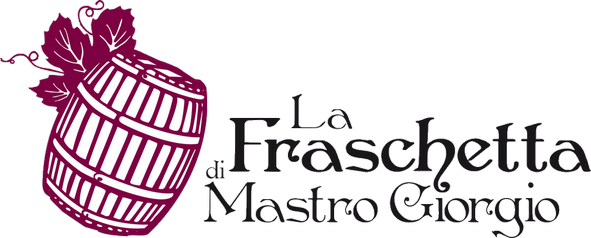The Apulia
The Italian culture of the tableDinner and tasting
Dinner and Tasting
Wednesday 27 September, 8.30pm
very limited places
La Fraschetta di Mastro Giorgio, Via Alessandro Volta 36, Testaccio (Rome)
Telling us the recipes: Chef Umberto Daeder
Telling us about the wines: Francesco for the Conti Zecca Cellar
To enrich the evening: the friselle from “I Contadini” / the pasta and preserves from < em>Ugento, Lecce
Menu
WELCOME:
Fried cod breast with ricotta and thyme on parsley sauce
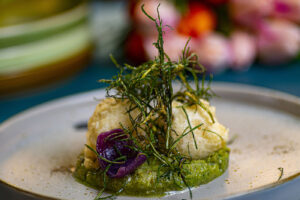
served with a glass of Sud Est Rosato Frizzante
*****
STARTER:
Apulian durum wheat frisella “I Contadini” with Dario tuna, beans and tomato
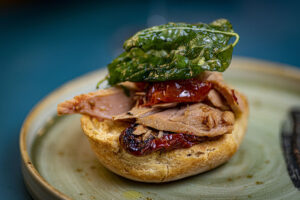
served with a glass of Mendola Fiano Salento IGT
*****
FIRST:
Tasting of Maritati with artisanal durum wheat flour, dried on a frame as in the past with turnip greens, black pork cheek and Cacioricotta “Slow Food Presidium ” grated
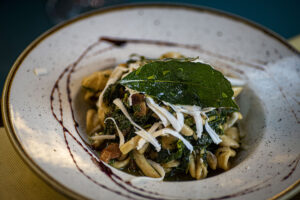
served with – Luna Salento IGT
*****
SECOND:
Bombetta from Martina Franca with lampascioni pancake
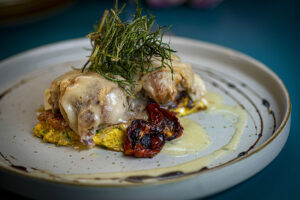
served with Liranu Negroamaro Riserva DOC
*****
SWEET:
Our style Lecce pasticciotto with custard and sour cherry jam
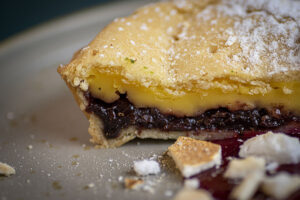
served with surprise Passito from Puglia
Participation: €60
Reservation no later than Monday 09-25-2023 subject to payment of a deposit of €10 per guest to:
La Fraschetta Srl
IBAN: IT42I 03440 03218 000 000 175 100
Bic/Swift BDBDIT22
Reason: tasting 09.27.23 for…people
Once the transfer has been made, it will be appropriate to report it to the contacts below.
Info and reservations:
06 574 1369
info@lafraschettadimastrogiorgio.com
Testaccio (Rome), Via Alessandro Volta 36
To know more…
Martina Franca’s bowler hat
The name of the Apulian bombette derives from the rounded shape that characterizes them, but it can also be thought to be evocative of the explosion of flavors that they unleash once they are bitten into. Bombette are small meat rolls prepared with slices of capocollo and stuffed with cheese, salt, pepper and spices. Their unique aroma spreads pleasantly in the air especially among the streets of the Valle d’Itria and in particular in Martina Franca, Cisternino and Locorotondo, but the entire region has adopted this recipe, creating local variations, one tastier than the other. Bombette are generally cooked on the grill or more often on the stoves of butchers: a real treat that you must absolutely try if you happen to be in these parts.
Burrata
Puglia is known for its variety of fresh and aged cheeses, ricotta, mozzarella, cacioricotta.
Burrata, among all cheeses, is one of the most loved and sought after for its buttery consistency and its fresh and enveloping flavor.
It is served alone or as an ingredient for creating pasta dishes. If eaten as a separate dish, it is served on a cutting board and cut in half and garnished with a drizzle of oil, fresh basil leaves, tomatoes and Apulian bread or taralli.
The Lampascioni
The lampascione is a herbaceous and purely wild plant of the Apulian Mediterranean maquis. “Lampascioni refuse to be cultivated: these little onions are born among the stones and they don’t taste like onions at all. They are bitter and sweet at the same time: they accept no other condiment than Puglian oil and pepper”. Our narrator friend has already spoiled everything for us: the lampascione bulbs grow about 20 cm underground and are similar to small onions, with a decidedly more bitter taste that can be partly eliminated by soaking them in water for a long time.
Their important aromatic profile necessarily calls for simple preparations: they are usually sautéed whole in a pan, pickled in oil or under the ashes. The only other ingredient they tolerate are eggs: hence the lampascioni omelette, a typical dish of the Apulian spring-summer. To make it, the bulbs are incised several times perpendicularly, so that once they are stewed they open up like small flowers and can be crushed: when they are practically ready, the beaten eggs are added.
The Taralli
Taralli are a must for a real Apulian aperitif, especially if you want to accompany your favorite wine or beer with something crunchy and tasty.
Taralli are essentially small bites of crusty bread cooked with a long and laborious process and are prepared with olive oil and white wine. There are numerous variations to the classic one: with fennel seeds, chilli pepper, onion, etc
The Pettole
The Taranto breasts are soft clouds of fried dough that are prepared on the day of Santa Cecilia and during the Christmas holidays. Tradition has it that they are served strictly hot and sprinkled with sugar, but some also like them in the salty version, that is, filled with anchovies, cherry tomatoes and capers.
Tiella Rice Potatoes And Mussels
Among the most loved typical Apulian foods there is certainly the tiella, a sort of Apulian paella that takes its name from the pot in which it is traditionally cooked. It is precisely in the tiella that rice, potatoes and mussels are placed to be mixed with onion, tomatoes, garlic, parsley and breadcrumbs, and finally baked. It was once enjoyed on holidays while today it is one of the most consumed recipes both hot in the cooler seasons and in summer as a cold and complete dish.
the maritati
Maritati are the marriage of two famous pasta shapes: orecchiette and macaroni. This typical Apulian product is eaten especially on Sundays and holidays. Why? Let’s find out with this identikit.
The origin of the term maritati derives from the fact that maccheroncini, also called maccarruni or minchiarieddi, in Apulian popular culture represent the symbol of male sexuality, while orecchiette are the symbol of female sexuality. Maritati therefore means married and this pasta shape was the protagonist of Salento wedding dinners in the past as a wish for a serene and fruitful marriage.
Orecchiette and maccheroncini are prepared with a dough made from durum wheat semolina and water. To make the macaroni, the dough is rolled around a special iron, “paduro”, which is then removed. Orecchiette, on the other hand, are made from strings of dough as thick as a finger and about 30 cm long which are cut into 1 cm portions and flattened with the thumb on the work surface and then turned over to obtain the classic dome shape. Once ready, the maritati are dried slowly at low temperatures.
The Pasticciotto Leccese
Pasticciotto was born way back in 1475, in a pastry shop in Galatina. It was the day dedicated to St. Paul, the town’s patron saint, and in the Ascalone pastry shop we thought about which dessert to prepare. Unfortunately, the pastry chef, a certain Nicola, had nothing but leftover pastry and custard. Think and think again and finally the pastry chef came up with the idea of lining an oval-shaped mold with shortcrust pastry and filling it with plenty of cream. Finally, he covered it with another layer of dough and put it in the oven. Once cooked, he baptized it “Pasticciotto di Ascalone”, but the dessert was so successful among the pilgrims, that it was renamed “Pasticiotto Leccese”.
